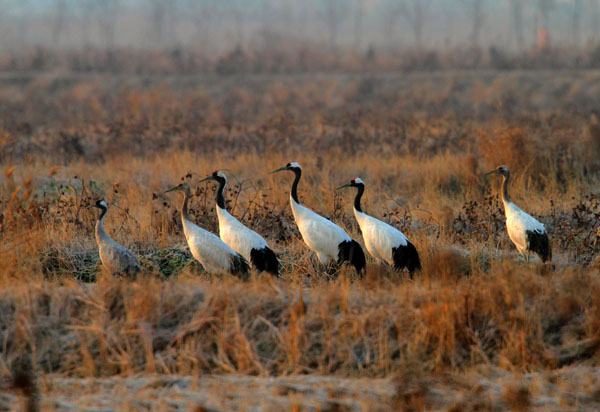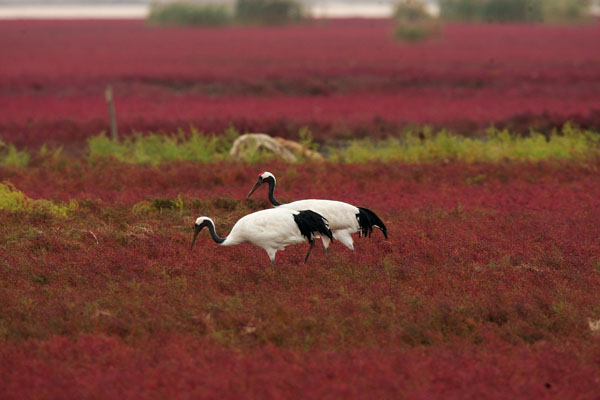Grus japonensis
IUCN
LCBasic Information
Scientific classification
- name:Grus japonensis
- Scientific Name:Grus japonensis,Red-crowned Crane, Japanese Crane, Manchurian Crane,Crane, Red-crowned Crane, White Crane, Mantilla
- Outline:Wading birds
- Family:F.Gruidae G.Grus.
Vital signs
- length:120-160cm
- Weight:7-10.5kg
- lifetime:50-60years
Feature
The legendary crane, known as the "God of the Wetlands", is often painted together with pine trees as a symbol of longevity.
Distribution and Habitat
In China, it breeds in wetlands such as the Sanjiang Plain in the northeast, and wintering groups are only found in a few places such as Yancheng, Jiangsu and the Yellow River Delta in Shandong. Abroad, it breeds in Japan and southeastern Siberia, and winters in Japan and the Korean Peninsula.
It inhabits open plains, swamps, lakes, grasslands, seashore mudflats, reeds, swamps, and riverbank swamps, and sometimes appears in farmland and cultivated land, especially during the migration season and winter.
Appearance
It is tall, with a slender neck, a red bare head, black eyes, cheeks, throat and neck sides, a wide white band extending from behind the eyes to the nape of the neck, white body feathers, black secondary and tertiary flight feathers, brown irises, green-gray beak, and black feet.
Details
The red-crowned crane is a large wading bird with a bright red head and distinct black and white bodies. It has very distinct features and is easy to identify. The skeleton of the red-crowned crane is hard on the outside and hollow on the inside. It is 7 times stronger than human skeletons. When migrating, it often forms a clever wedge shape, so that the individuals behind can use the airflow generated by the flapping wings of the individuals in front in turn, so as to fly quickly, labor-savingly and sustainably. The speed can reach about 40 kilometers per hour, the flying altitude can exceed 5,400 meters, and it can sing while flying. The high-pitched and loud singing of the red-crowned crane is related to its special vocal organs. It has a long neck and a long syrinx, which is more than 1 meter long, which is five or six times the length of the human trachea. The end is rolled into a ring and coiled between the sternum, just like the brass instruments in Western music. When it sounds, it can cause strong resonance, and the sound can be transmitted 3-5 kilometers away.

Adult red-crowned cranes molt twice a year, changing to summer feathers in spring and winter feathers in autumn. This is a complete molt and they will temporarily lose their ability to fly.
They often move in pairs or in family groups or small groups. During the migration season and winter, they often form larger groups of several or dozens of family groups. Sometimes the group can be as many as 40-50 or even more than 100. However, when they are active, they still disperse into small groups or family groups within a certain area. At night, they roost on shallow beaches surrounded by water or by reed ponds. They still roost in separate family groups, but they get very close when it is particularly cold. When resting, they often stand on one leg with their head turned back and inserted between their back feathers. Whether foraging or resting, there is often one adult bird that is particularly alert, constantly looking up and looking around. When it finds danger, it makes a "ko-lo-lo-" sound, and stretches its head and neck upward and looks up to the sky when it calls. When danger is approaching, it flies into the air. When flying, the head and feet are stretched forward and backward, and the wings flap slowly, forming a "one" or "V" shape.
The foraging and night roosting sites are generally relatively fixed. Usually after dawn, each family group flies to the foraging site to forage, and still keeps a certain distance from each other. At noon, they often gather on the beach to rest and keep calling. At night, they fly back to the night roosting site or stay in the foraging site to spend the night. The food is very diverse, mainly including fish, shrimp, aquatic insects, mollusks, tadpoles, sandworms, clams, snails, and stems, leaves, tubers, bulbs and fruits of aquatic plants, etc.
It is recognized as a first-class literary bird in Chinese history. The Ming and Qing dynasties endowed the red-crowned crane with the cultural connotation of loyalty, integrity and noble character. The red-crowned crane was embroidered on the official uniform of the first-rank civil official, and it was listed as an important symbol second only to the dragon and phoenix used exclusively by the royal family, so people also called the crane "the first-rank bird". People also regard the crane as a symbol of high-ranking officials. A lucky pattern of a crane standing on a rock at the head of the tide, taking the homophony of "tide" and "dynasty", symbolizes "the first-rank court" like the prime minister; the pattern of a crane flying in the clouds symbolizes "the first-rank promotion"; the pattern of a crane flying at sunrise symbolizes "promotion in the near future".

Residents in East Asia use the red-crowned crane to symbolize happiness, auspiciousness, longevity and loyalty. It has appeared frequently in the literature and art works of various countries. In the tombs of the Shang Dynasty, the image of the crane appeared in sculptures. In the bronze bells of the Spring and Autumn Period and the Warring States Period, ritual vessels in the shape of cranes had already appeared.
In 2003, the State Forestry Administration of China and the China Wildlife Conservation Association launched the national bird selection activity, established an expert selection group and determined the selection criteria. From May to June 2004, the China Wildlife Conservation Association, China News Service, and Sina.com jointly organized an online campaign to nominate the national bird with more than 20 news websites across the country. Among the 10 candidate bird species, the red-crowned crane received 64.92% of the votes from 5 million netizens, far ahead of other competitors. The State Forestry Administration of China reported the red-crowned crane as the only candidate for the national bird to the State Council.
The total number of red-crowned cranes in the world is estimated to be only about 1,500 by 2010, of which about 1,000 are wintering in China. Protecting the red-crowned cranes and their living environment has attracted the attention of more and more people. China has established more than 18 nature reserves mainly for the protection of red-crowned cranes. Among them, Jilin Xianghai, Hunan Dongting Lake, Qinghai Bird Island and Jiangxi Poyang Lake are also included in the international La Musar Treaty protected wetland list, which has made great progress in protection work.
Listed as the first level in China's "National List of Key Protected Wildlife" (February 5, 2021).








